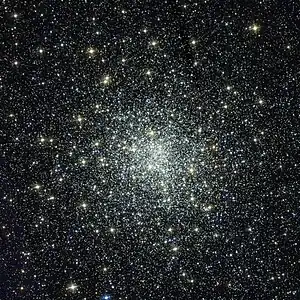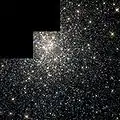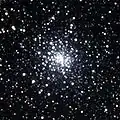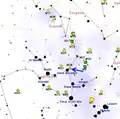| Messier 28 | |
|---|---|
 Globular cluster Messier 28 in Sagittarius | |
| Observation data (J2000 epoch) | |
| Class | IV[1] |
| Constellation | Sagittarius |
| Right ascension | 18h 24m 32.89s[2] |
| Declination | –24° 52′ 11.4″[2] |
| Distance | 18.26 ± 0.98 kly (5.6 ± 0.3 kpc)[3] |
| Apparent magnitude (V) | 6.8[4] |
| Apparent dimensions (V) | 11′.2[5] |
| Physical characteristics | |
| Mass | 5.51×105[6] M☉ |
| Radius | 30 ly[7] |
| VHB | 15.55 ± 0.10[8] |
| Metallicity | = –1.32[6] dex |
| Estimated age | 12.0 Gyr[9] |
| Notable features | Contains first pulsar discovered in a globular[10] |
| Other designations | GCl 94, M 28, NGC 6626[2] |
Messier 28 or M28, also known as NGC 6626, is a globular cluster of stars in the center-west of Sagittarius. It was discovered by French astronomer Charles Messier in 1764.[11][lower-alpha 1] He briefly described it as a "nebula containing no star... round, seen with difficulty in 31⁄2-foot telescope; Diam 2′."[12]
In the sky it is less than a degree to the northwest of the 3rd magnitude star Kaus Borealis (Lambda Sgr). This cluster is faintly visible as a hazy patch with a pair of binoculars[11] and can be readily found in a small telescope with an 8 cm (3.1 in) aperture, showing as a nebulous feature spanning 11.2 arcminutes. Using an aperture of 15 cm (5.9 in), the core becomes visible and a few distinct stars can be resolved, along the periphery. Larger telescopes will provide greater resolution,[5] one of 25 cm (9.8 in) revealing a dense 2′ core, with more density within.[11]
It is about 18,300 light-years away from Earth.[3] It is about 551000 M☉[6] and its metallicity (averaging −1.32 which means more than 10 times less than our own star), coherency and preponderence of older stellar evolution objects, support its dating to very roughly 12 billion years old.[9] 18 RR Lyrae type variable stars have been found within.
It bore the first discovery of a millisecond pulsar in a globular cluster – PSR B1821–24. This was using the Lovell Telescope at Jodrell Bank Observatory, England.[10] A total of 11 further of these have since been detected in it with the telescope at Green Bank Observatory, West Virginia. As of 2011, these number the third-most in a cluster tied to the Milky Way, following Terzan 5 and 47 Tucanae.[13]
Gallery

 2.5' view of M28 taken by Hubble Space Telescope.
2.5' view of M28 taken by Hubble Space Telescope. Messier 28 on 2MASS; wide angle
Messier 28 on 2MASS; wide angle Map showing location of M28
Map showing location of M28
See also
References and footnotes
References
- ↑ Shapley, Harlow; Sawyer, Helen B. (August 1927), "A Classification of Globular Clusters", Harvard College Observatory Bulletin, 849 (849): 11–14, Bibcode:1927BHarO.849...11S.
- 1 2 3 "M 28". SIMBAD. Centre de données astronomiques de Strasbourg. Retrieved 2006-11-16.
- 1 2 Oliveira, R. A. P.; Ortolani, S.; Barbuy, B.; Kerber, L. O.; Maia, F. F. S.; Bica, E.; Cassisi, S.; Souza, S. O.; Pérez-Villegas, A. (2022). "Precise distances from OGLE-IV member RR Lyrae stars in six bulge globular clusters". Astronomy & Astrophysics. 657: A123. arXiv:2110.13943. Bibcode:2022A&A...657A.123O. doi:10.1051/0004-6361/202141596. S2CID 239998638.
- ↑ "Messier 28". SEDS Messier Catalog. Retrieved 28 April 2022.
- 1 2 Inglis, Mike (2004), Astronomy of the Milky Way: Observer's guide to the northern sky, Patrick Moore's Practical Astronomy Series, vol. 1, Springer, p. 21, Bibcode:2003amwn.book.....I, ISBN 978-1852337094.
- 1 2 3 Boyles, J.; et al. (November 2011), "Young Radio Pulsars in Galactic Globular Clusters", The Astrophysical Journal, 742 (1): 51, arXiv:1108.4402, Bibcode:2011ApJ...742...51B, doi:10.1088/0004-637X/742/1/51, S2CID 118649860.
- ↑ From trigonometry: radius = distance × sin( diameter_angle / 2 ) = 30 ly
- ↑ Testa, Vincenzo; et al. (February 2001), "Horizontal-Branch Morphology and Dense Environments: Hubble Space Telescope Observations of Globular Clusters NGC 2298, 5897, 6535, and 6626", The Astronomical Journal, 121 (2): 916–934, Bibcode:2001AJ....121..916T, doi:10.1086/318752
- 1 2 Koleva, M.; et al. (April 2008), "Spectroscopic ages and metallicities of stellar populations: validation of full spectrum fitting", Monthly Notices of the Royal Astronomical Society, 385 (4): 1998–2010, arXiv:0801.0871, Bibcode:2008MNRAS.385.1998K, doi:10.1111/j.1365-2966.2008.12908.x, S2CID 17571531
- 1 2 "JBO - Stars". Jodrell Bank Observatory. Retrieved 2007-06-01.
- 1 2 3 Thompson, Robert Bruce; Thompson, Barbara Fritchman (2007), Illustrated Guide to Astronomical Wonders, Diy Science, O'Reilly Media, Inc., p. 402, ISBN 978-0596526856.
- ↑ Burnham, Robert (1979), Burnham's celestial handbook: an observer's guide to the universe beyond the solar system, Dover books explaining science, vol. 3 (2nd ed.), Dover Publications, p. 1609, ISBN 978-0486236735
- ↑ Bogdanov, Slavko; et al. (April 2011), "Chandra X-ray Observations of 12 Millisecond Pulsars in the Globular Cluster M28", The Astrophysical Journal, 730 (2): 81, arXiv:1101.4944, Bibcode:2011ApJ...730...81B, doi:10.1088/0004-637X/730/2/81, S2CID 118621389
- ↑ "Nebulous, but no nebula". www.spacetelescope.org. Retrieved 11 March 2019.
Footnotes
- ↑ On July 27
